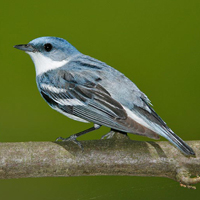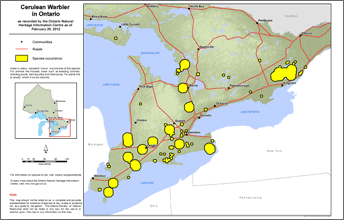Cerulean warbler
Scientific name: Setophaga cerulea

Photo credit: Brian E. Small
Status
Threatened
“Threatened” means the species lives in the wild in Ontario, is not endangered, but is likely to become endangered if steps are not taken to address factors threatening it.
Date added to the Species at Risk in Ontario List
June 8, 2011
Read the Assessment Report
What it looks like
The Cerulean Warbler is a small songbird – about 10 to 12 centimetres long – with long wings and a short tail. The adult male is deep blue on top, with white under parts and a distinctive blue-black band across the throat.
The adult female is blue-green on top, with whitish under parts that often appear to have a yellowish tint, and yellow-white eyebrows. Both males and females have two prominent white wing bars and white tail spots.
These birds usually raise one brood of three or four nestlings each year. The Cerulean Warbler feeds mainly on insects during the breeding season and on nectar during the non-breeding season. Young birds are fed primarily butterfly larvae.
Where it lives
Cerulean Warblers spend their summers (breeding seasons) in mature, deciduous forests with large, tall trees and an open under storey.
In late summer, they begin their long migration to wintering grounds in the Andes Mountains in South America.
Where it’s been found in Ontario
The Cerulean Warbler’s breeding range extends from extreme southwestern Quebec and southern Ontario west to Minnesota and Nebraska and south to Texas and other Gulf states across to North Carolina.
In southern Ontario, populations appear to be separated into two distinct bands: one from southern Lake Huron to western Lake Ontario, and further north, the other from the Bruce Peninsula and Georgian Bay area to the Ottawa River.
View a larger version of this map (PDF)
What threatens it
In Ontario and the United States, the main threat to this warbler is habitat loss from degrading and fragmenting forests, since it requires relatively large tracts of forest.
On the South American wintering grounds, this bird’s forest habitat is under a high degree of threat from logging.
Action we are taking
Threatened species and their habitat are protected under Ontario’s Endangered Species Act, 2007.
Recovery strategy
A recovery strategy advises the ministry on ways to ensure healthy numbers of the species return to Ontario.
Read the executive summary and the full document (September 6, 2022).
Government response statement
A government response statement outlines the actions the government intends to take or support to help recover the species.
Read the government response statement (June 6, 2023)
Habitat protection
General Habitat Protection - June 8, 2011
What you can do
Report a sighting
- Report a sighting of an endangered animal or plant to the Natural Heritage Information Centre. Photographs with specific locations or mapping coordinates are always helpful.
Volunteer
- Volunteer with your local nature club or provincial park to participate in surveys or stewardship work focused on species at risk.
Be a good steward
- Private land owners have a very important role to play in species recovery. If you find a Cerulean warbler nesting on your land, you may be eligible for stewardship programs that support the protection and recovery of species at risk and their habitats.
- Bird Studies Canada is working to advance the understanding, appreciation and conservation of wild birds and their habitat in Ontario and elsewhere.
- The Carolinian forests of southern Ontario support an amazing diversity of plants and wildlife, including many species at risk. Carolinian Canada is working to help recover species at risk and their habitats.
Report illegal activity
- Report any illegal activity related to plants and wildlife to
1-866-MOE-TIPS (663-8477) .
Quick facts
- Since this warbler is a bird of the tree tops, it is often best identified from below. Birdwatchers will recognize adult males by the thin dark band that crosses the upper part of the predominantly white breast.
- When re-nesting if a first nest fails, the female often recycles spider web from the old nest to start construction on the new nest. Fresh lining is gathered for the new nest, but spider web may be too valuable and time-consuming to waste.
- The female Cerulean Warbler has an unusual way of leaving a nest after sitting on it a while, sometimes called "bungee-jumping." She drops from the side of the nest, keeping her wings folded to her sides, and opens her wings to fly only when she is well below the nest.
- The Cerulean Warbler takes about four months to travel from its North American breeding grounds to the South American Andes, and another two months to return to Canada and the United States the following spring.
- One threat to Cerulean Warblers is "nest parasitism" by Brown-headed Cowbirds. The cowbirds lay their eggs in other species’ nests, and the young cowbirds are fed by the host parents at the expense of their own young.
